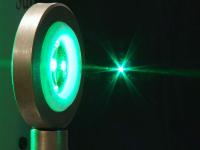Optical fibres pose no mystery to them – Students' Optoelectronics Association
Last year, they managed to induce plasma in optical fibre core, and today they build a modular medium-power laser. Although their work may not seem spectacular, members of Students' Optoelectronics Association consistently develop their skills along with innovative technology.
Students' Optoelectronics Association has worked on fibre fuse, for which they received Rector’s grant in 2015. As a continuation of that research, with co-financing from 2016 Research Project Big Pool, they have gone for a new challenge, which is building a medium-power laser based on thulium fibre. The Institute of Microelectronics and Optoelectronics of the Faculty of Electronics and Information Technology supports research conducted by the Association and Professor Ryszard Piramidowicz is the Association’s supervisor.
It all started with plasma induction
Triggering plasma in optical fibre core was not an easy task. Such experiments have not been conducted in Poland so far. However, Students' Optoelectronics Association has decided to face the challenge. The application of high optical intensity to the fibre was a key success factor in initiating the phenomenon. And it must be remembered that optical fibre core, to which radiation was introduced, has a diameter smaller than that of human hair. Yet, with the use of appropriate tools it was possible to induce fibre fuse.
What happens when plasma is induced in optical fibre? The introduced radiation causes material ionisation. As a result, optical fibre is damaged and cannot carry information any more. At the same time, energy is released in the form of light.
This phenomenon aroused curiosity of the association’s members who decided to look into it. When plasma is excited in optical fibre, its core gets damaged and it can no longer carry information. “If plasma was induced in existing service infrastructure, it would result in considerable loss”, says Bartosz Janaszek, President of the Association. This is why we would like to develop a method of protection against such threat.
From inspiration to a project
Today, fibre lasers are one of the fastest developing sectors of laser technology. Fibre laser based systems play an increasingly important role in industry, telecommunications and research.
Thulium optical fibre, which the members of Students' Optoelectronics Association intend to use, is characterised by a unique wave length. The problem is, however, that such fibre is not manufactured in Poland. Initial works are conducted at the Maria Curie-Skłodowska University in Lublin, yet there is a long way to go before the fibre is mass manufactured.
In the future, the thulium fibre developed by the Students' Optoelectronics Association could be used for micromachining of materials; hardfacing, labelling or cutting. The fact that the laser operates in mid-infrared spectrum (ca. 1.9 μm) makes it possible for the application of a particle detection system (e.g. gases, explosives, microorganisms in the air) over a large area.
Knowledge propagation
Students' Optoelectronics Association at the Warsaw University of Technology organises training and seminars. A recent event focused on the operation of OptiSystem program used for the simulation of optoelectronic systems operation (lasers, receivers, filters etc.). To the surprise of Association members, it attracted not only students, but also research staff of WUT.
Association members encourage their peers to join them. “We do not expect that you have extensive knowledge on all the topics we deal with when you join us”, says Radosław Piekarski, Association’s Board Member. “We work in association to learn something new. Our goal is to expand knowledge”.
The development of an operational mid-power fibre laser is an interdisciplinary effort involving such areas of knowledge as photonics, electronics and optoelectronics. Thus, project work provides ample opportunities for cooperation with other students’ research associations.
Author: Monika Bukowska
Office of Promotion and Information








